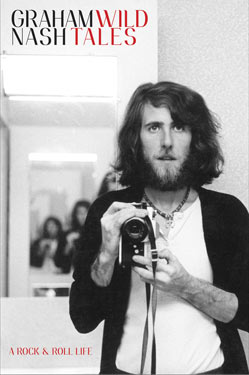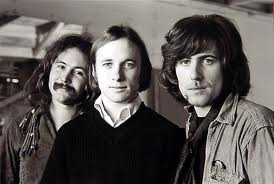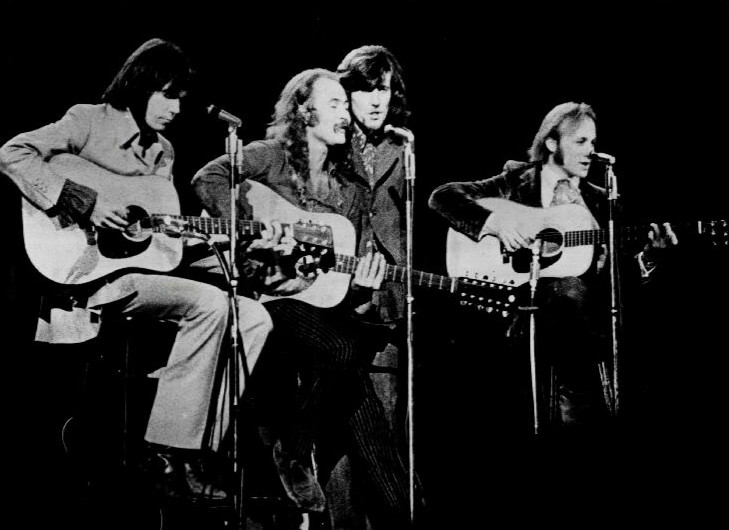Two time Rock and Roll Hall of Fame inductee Graham Nash knows a
thing or two about chemistry. As a founding member of The Hollies
and Crosby, Stills & Nash (CSN)/ Crosby, Stills, Nash & Young (CSNY)
or various iterations of the same, his delicate voice has helped
create some of the most magnificent harmonies in rock and roll...
from '"Carrie Anne" to "Our House."
Nash's latest project, the book Wild
Tales: A Rock and Roll Life, lives up to its name. It details a
colorful life marked by picture perfect moments of beatific harmony
alongside raw snapshots of disharmony.
“I wanted you
to hear my voice while reading the book,” observes Nash. “I wanted
it to feel like I was just sitting in your living room talking to
you.”
Frank and intimate, in Wild
Tales Nash pulls no
punches. He chronicles in vivid detail a musical and personal
journey that unfolds like an unfinished song. By story's end, it
winds up as a beautiful symphony.
PopEntertainment.com writer Ken Sharp spoke with Nash.
Doing the
book, what did you learn about yourself and your fellow band mates?
I really
believe that I like people. I love David [Crosby], I love Stephen
[Stills], I love Neil [Young]. And I love Joan [Joni Mitchell]. I
really like these people. When I looked down at the manuscript after
I read everything that I put down was, “Oh my God, I wish I was
him.” (laughs) It’s been such a wild life. It’s not only
about sex, drugs and rock and roll – which sells books of course –
but it’s about loyalty and friendship and love.
 You
grew up in Salford, England. You said, “Dreams were often the only
way out.” What were your dreams as a kid?
You
grew up in Salford, England. You said, “Dreams were often the only
way out.” What were your dreams as a kid?
I’ve known
since I was thirteen-years-old that I wanted to be a rock and roll
musician. At school I wouldn’t be doing my homework. I’d be drawing
drum kits and Fender guitars and practicing my autograph at
thirteen.
You wrote
“King Midas in Reverse” for The Hollies. Recount writing and
recording the song. Could you sense it was an artistic breakthrough?
It was one of
the reasons why I left the Hollies. We had an agreement where
whatever we wrote was always split three ways. I started to write
songs where they didn’t contribute anything. I was still sharing it
and it upset me, so I had to stop that. I thought I’d written a
pretty decent song with “King Midas in Reverse.” It was very
emotional for me. I was talking about myself, of course, and I did
think we cut a great record of it. I’m still very pleased when I
hear the record of “King Midas in Reverse.” I think it was
definitely a step in the right direction for me as a writer. I began
to realize that songs are more than just “Moon, June, screw me in
the back of the car.” I’ve got nothing against those kinds of songs.
I wrote many of them myself (laughs), especially when I was
with The Hollies. But I began to realize that there was a lot going
in the world that needed to be spoken about. Needed to be examined
and have some sunshine lighting it up.
Take us back
to your fateful meeting with David Crosby and Stephen Stills and
singing for the first time. You asked them to play “You Don’t Have
to Cry.”
I’d come from
London to Los Angeles to meet with Joni Mitchell, who I was going
out with at the time. We were in her living room and David and
Stephen were there. We finished dinner and David said, “Hey Stephen,
sing Willie that song.” It was the song “You
Don’t Have to Cry,” which I personally think is a really brilliant
song. They sang it. It sounded great in two part harmony. I said,
“Sing it again.” They looked at each other and said, “Okay.” They
sang it again. Then I said, “Okay, well bear with me now. Sing it
one more time.” I had my harmony down. Whatever vocal sound that CSN
has was born in that first forty seconds.
 Once
you joined CSN, your writing took a great leap forward from your
work in The Hollies. What precipitated that evolution? Was it simply
a case of you trying to up your game surrounded by other incredible
writers... a la Stills with “Suite: Judy Blue Eyes.”
Once
you joined CSN, your writing took a great leap forward from your
work in The Hollies. What precipitated that evolution? Was it simply
a case of you trying to up your game surrounded by other incredible
writers... a la Stills with “Suite: Judy Blue Eyes.”
I wasn’t
trying to up my game. I was witnessing the way Crosby wrote and the
way Joni wrote. Unbelievable songwriters. They were very different
from what I had been trained to do with The Hollies, writing these
two and a half minute pop singles that you can’t forget,
unfortunately. When I watched David and Stephen and Neil and Joni
write, obviously you get affected by witnessing such great stuff. I
started to get really, really serious about songwriting. Not that I
wasn’t serious before, but I realized there’s a lot going on in the
world that needs to be spoken about.
With CSN, you
established a democracy only doing songs that you loved.
We have kind
of an unspoken rule with me, David, Stephen and with Neil. That is
this – if I play you a song an you don’t particularly react, you’ll
never hear that song again. But if I play you a song and you go, “Oh
man, I know what to do in the choruses” or Stephen and Neil go, “We
can work out this guitar line,” now we’re interested. So that’s kind
of an unspoken rule with us. W e call it, strangely enough, the
reality rule. Is the song good enough to exist? Is it good
enough for the other people to be involved?
How has a band
that’s all about harmony managed to survive all these years dealing
with many moments of disharmony?
We have a
great sense of survival and I think that we all know the music’s the
most important part of our relationship. So we’ve always tried to
concentrate on that, in spite of all the stuff that’s been going on
and in spite of all those stories in my book Wild Tales. We
knew that the music was the most important thing.
 Your
role in CSN and CSNY has been as the diplomat. Is that a fair
description?
Your
role in CSN and CSNY has been as the diplomat. Is that a fair
description?
I think that’s
a pretty good representation. I like an easy life. I like us to keep
on the path of going where we’re supposed to be going. I try to keep
myself concentrated on that path. Whenever we go astray, I keep
reminding them just how important the music is. How it affects the
lives of millions of people.
Working with
three vocalists in CSN on harmony parts, the addition of Neil to the
vocal mix proved challenging for the group. Why?
Because
three-part harmony is different than four-part harmony. It’s very,
very different. You have to change the tonal structure of the whole
thing. It sounds different. But, so what?! We sing well with Neil.
Wait until you hear some of the live stuff on CSNY Live 1974
[an archival concert box set being released in August 2014]. It’s
tremendous. I’m thrilled with it musically.
Why was it
called “The Doom Tour”?
I didn’t call
it that. Crosby did. From what I’m putting together right now – I’m
only eleven mixes from the end of this collection; I think there
might be forty songs on this box set – it soars to me. David called
it “The Doom Tour” because he kept trying to sing “Guinnevere” with
one guitar and two voices to 100,000 people. It just didn’t work.
It’s too big. That’s why David called it “The Doom Tour.” I didn’t
think it was “The Doom Tour.” I had a great time myself. I think the
music will show people how good a time we were having.
Tell us more
about the live ’74 CSNY box set.
In 1974 CSNY
did a series of shows in stadiums and basketball arenas. We played
thirty-one venues and recorded nine of them in multi-track. Me and
my friend Joel Bernstein listened to every single inch of tape,
every second of music that we had made on multi-track and put
together this album that is thrilling me. I’m not unthrillable but
I’m certainly hard to move. This music is a great representation of
who this band is.
Listening back
almost forty years later, was it better than you thought?
Yes. It was
much better than my memory of it all. We did 31 shows with an
average audience attendance of about seventy thousand people. We
were moving so fast with helicopters and private jets, it was a bit
of a blur. In investigating the tapes and finding the best delivery
of the songs, I fell back in love with who these guys are, man. CSNY
was a formidable band. We had four very strong writers and four very
strong personalities and four very strong musicians.
|
CHECK OUT A
COUPLE OF VINTAGE PERFORMANCES OF GRAHAM NASH'S GREATEST CSN HITS, "OUR
HOUSE" AND
"WASTED ON THE WAY"!
|
Email
us Let us know what you
think.